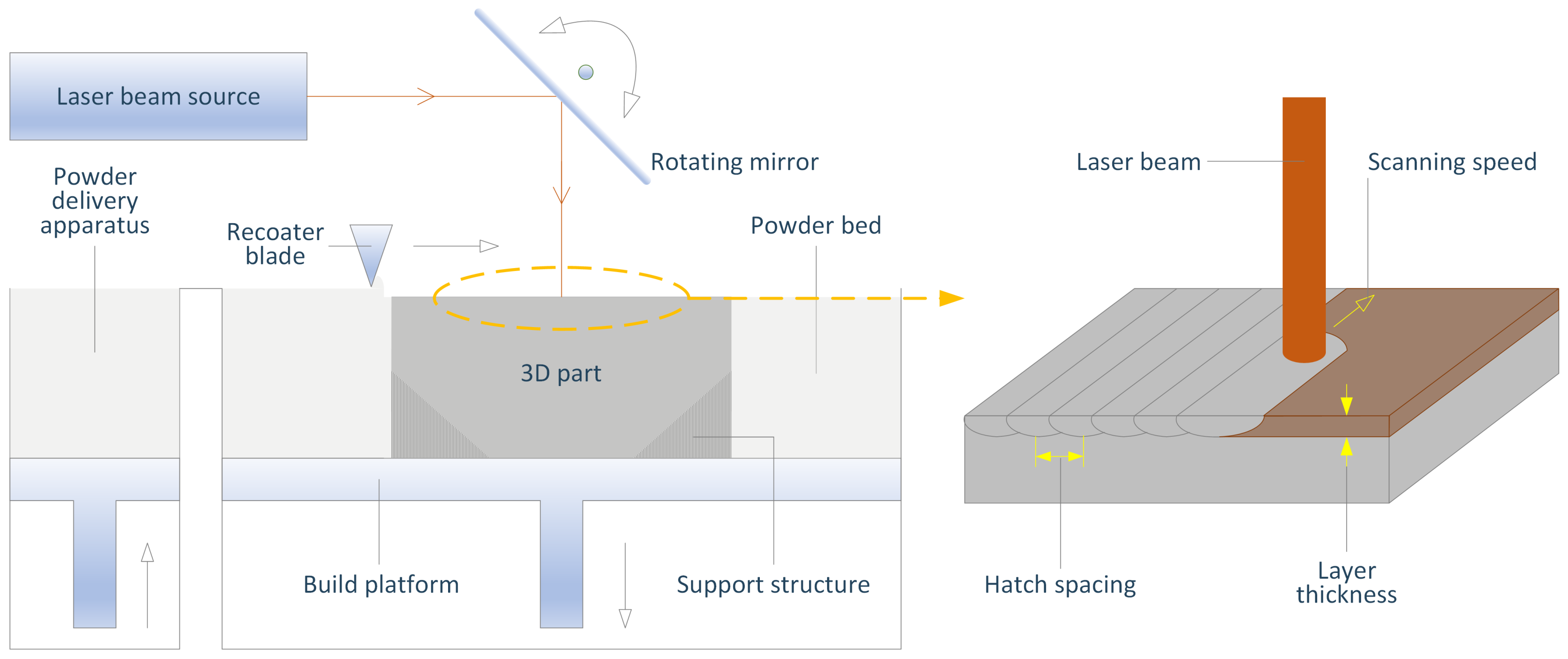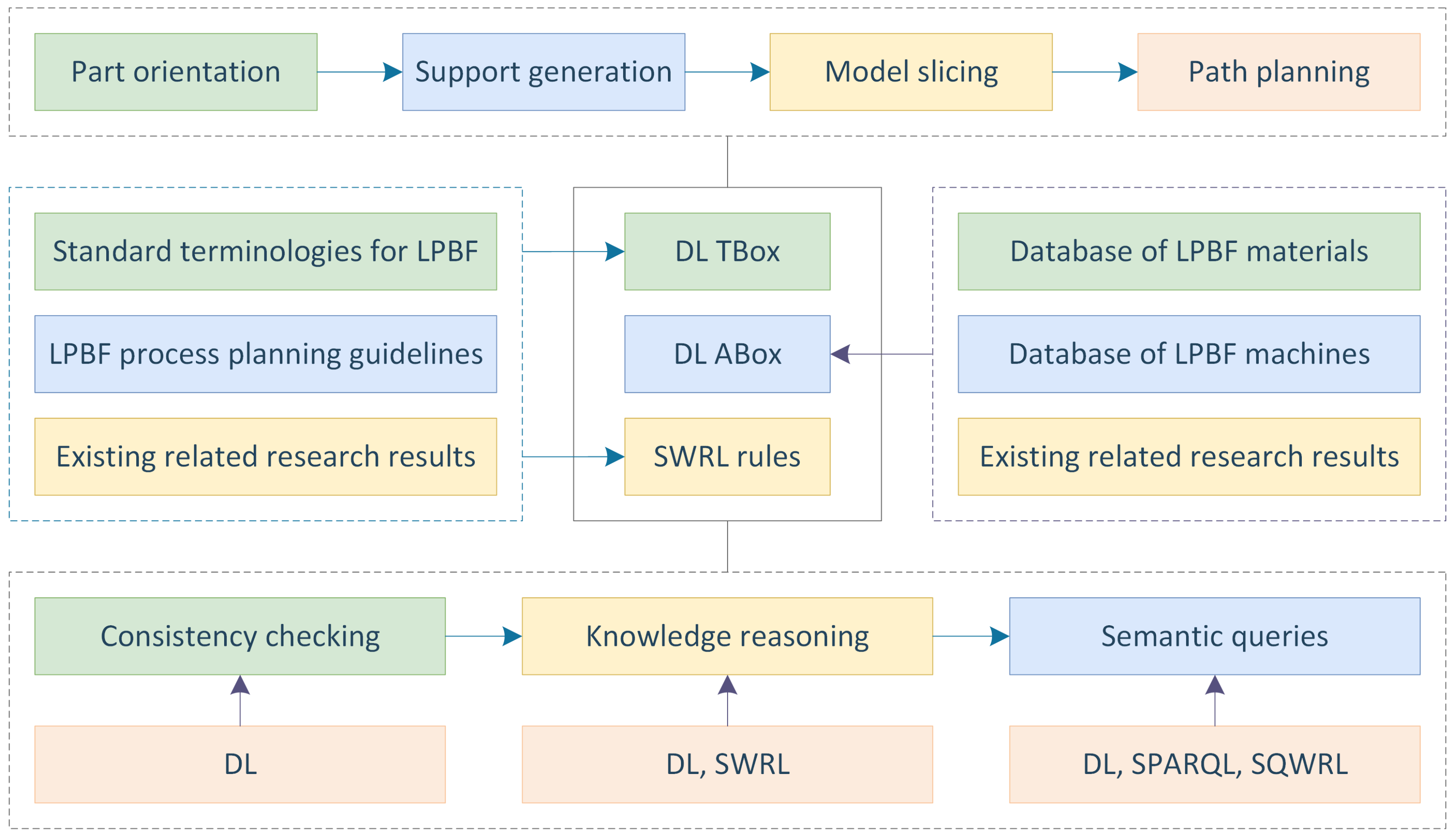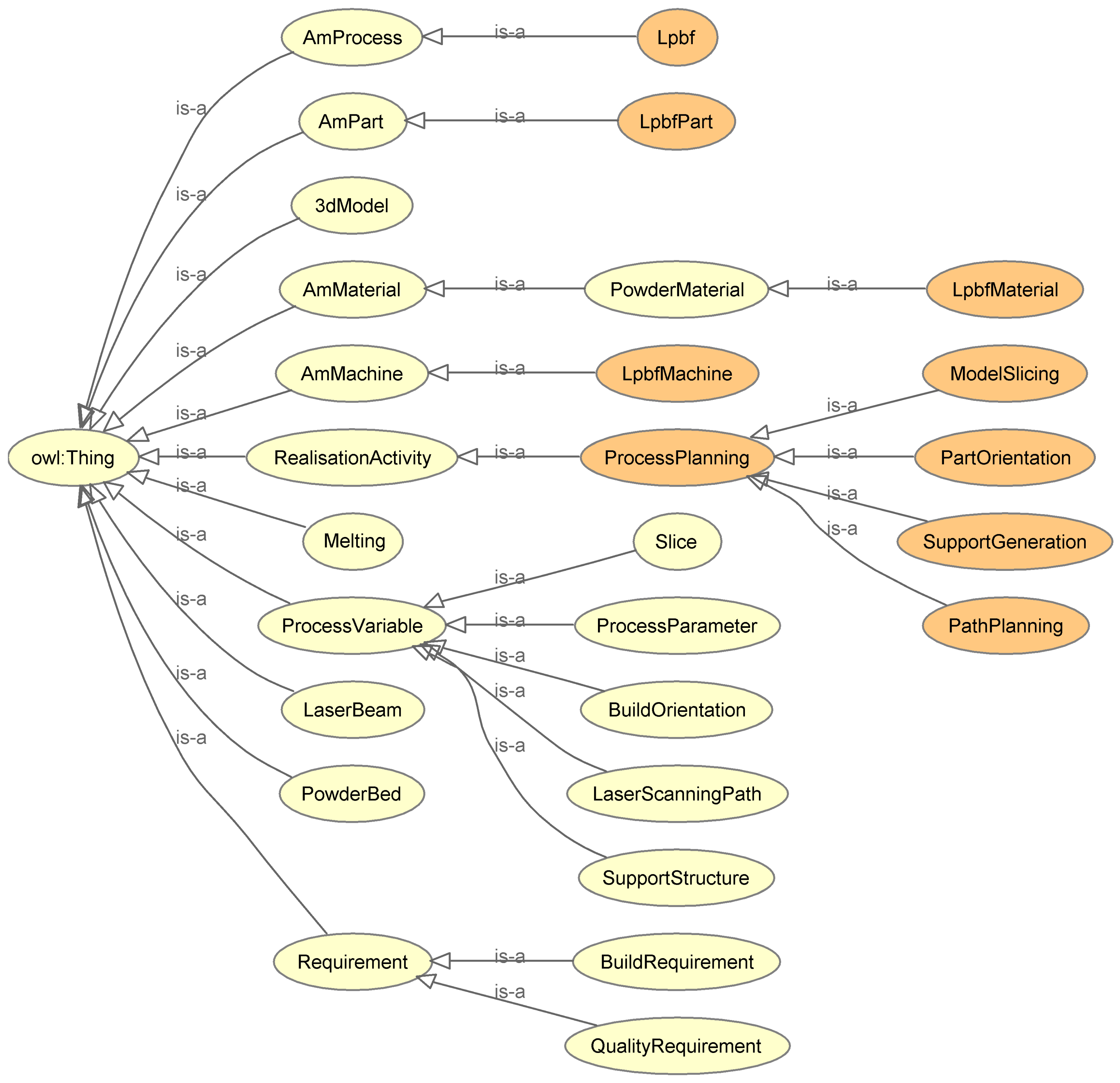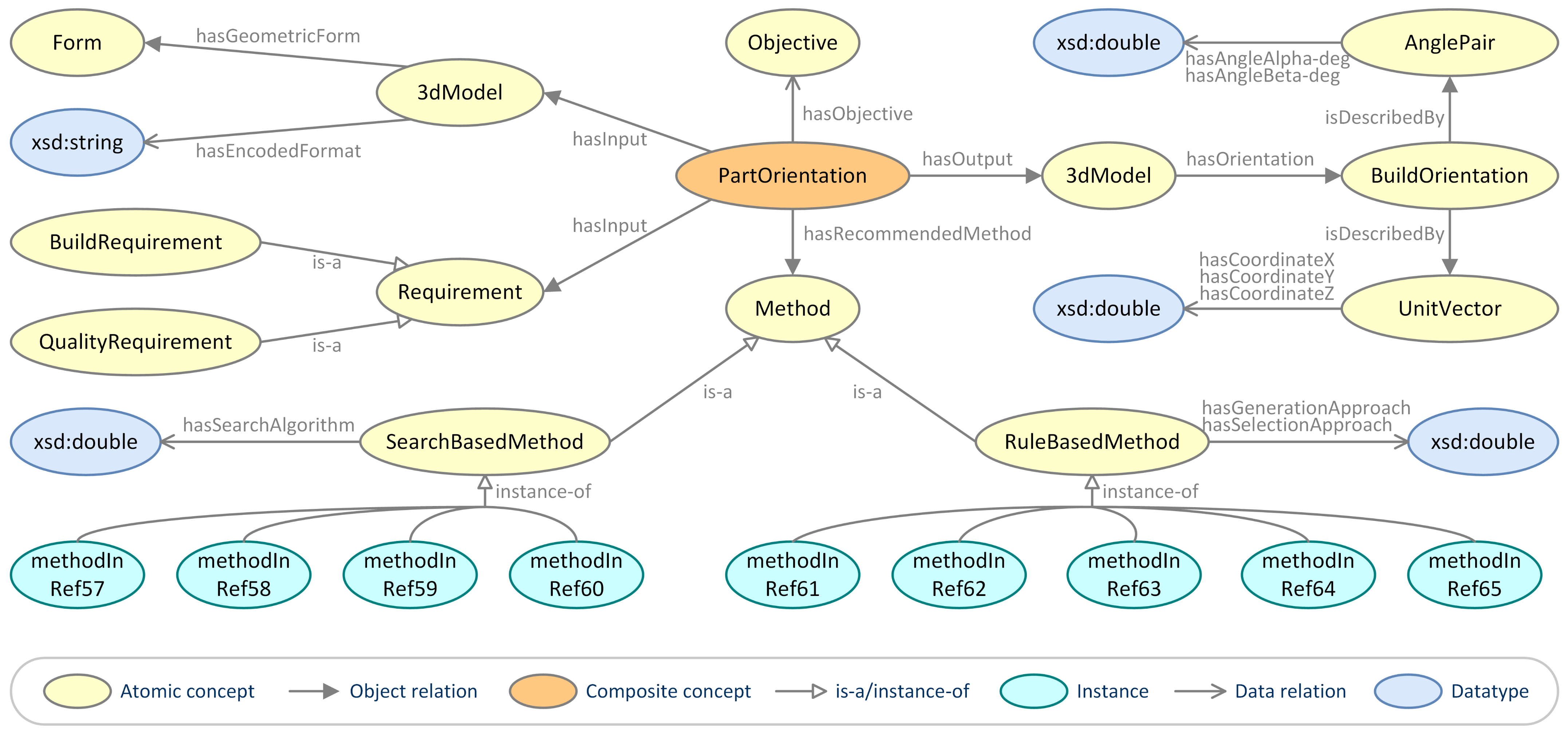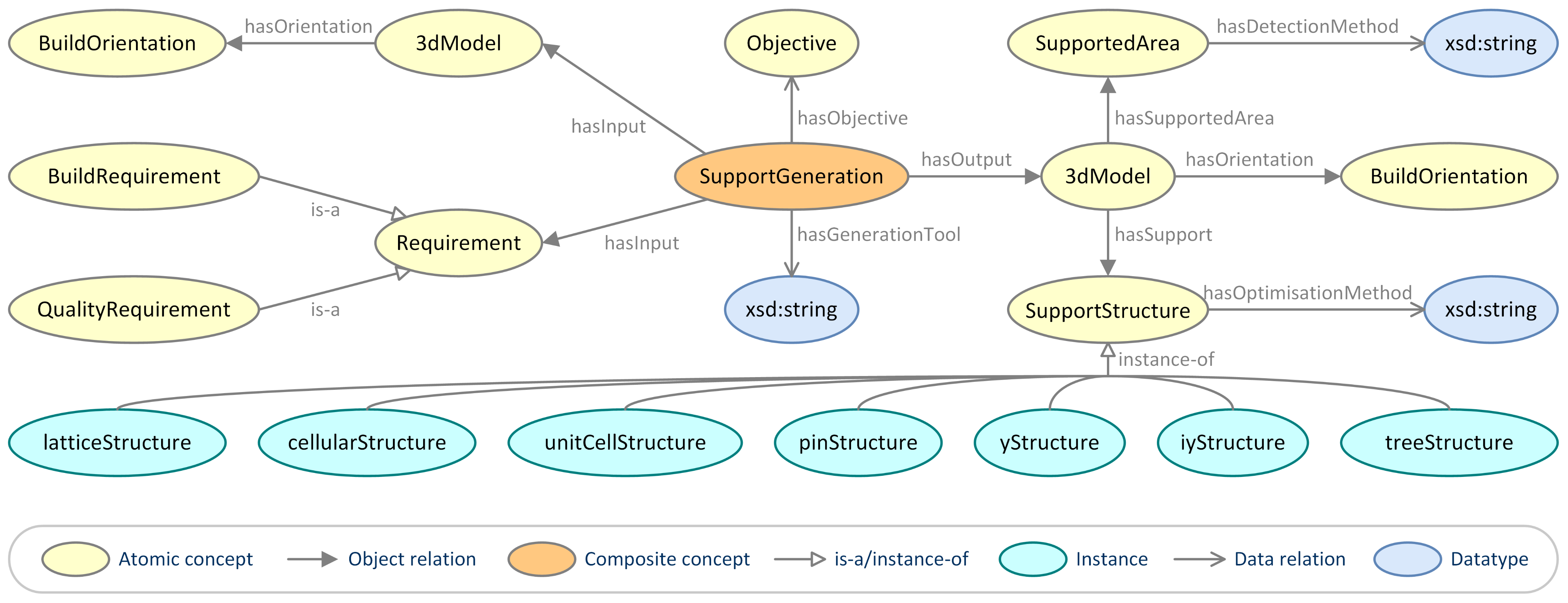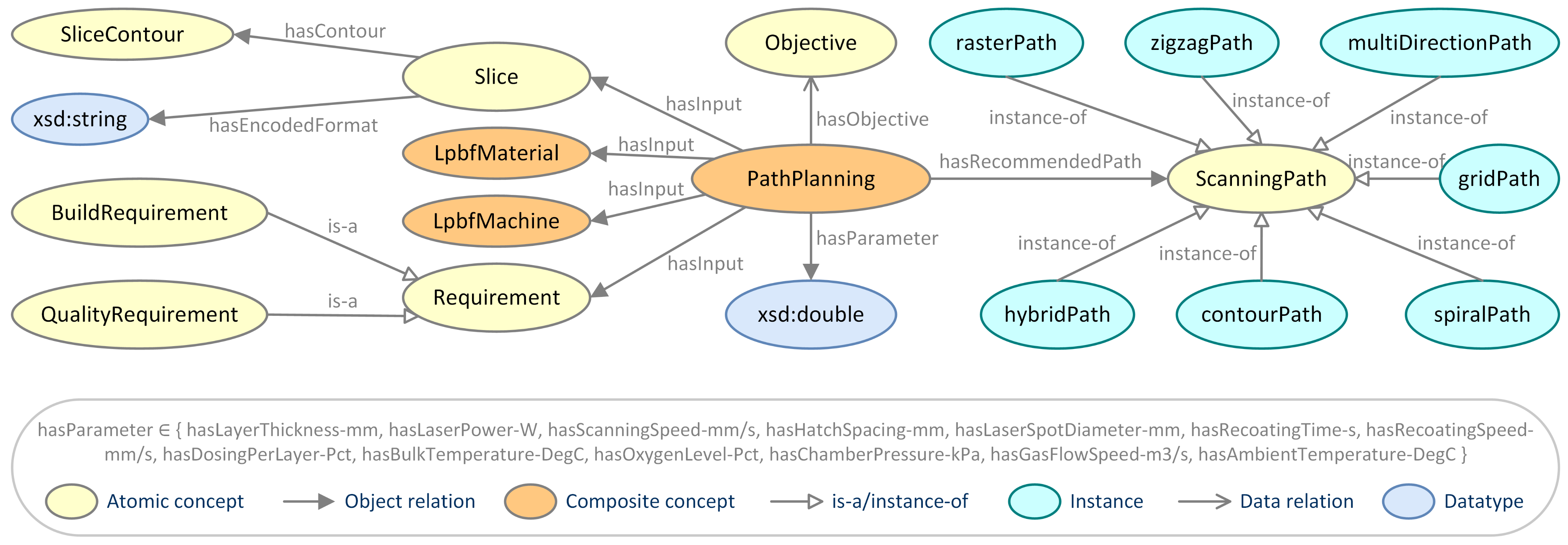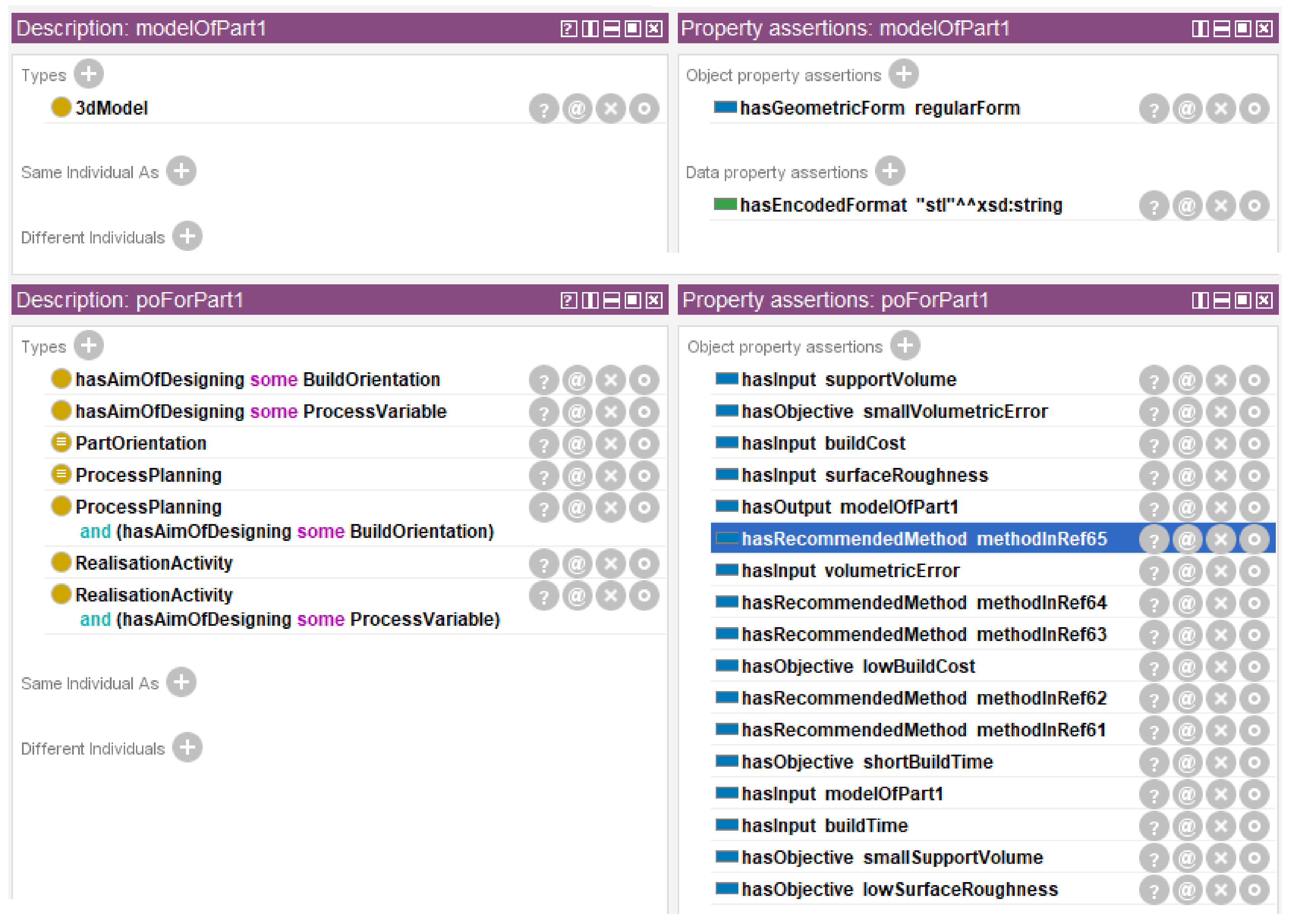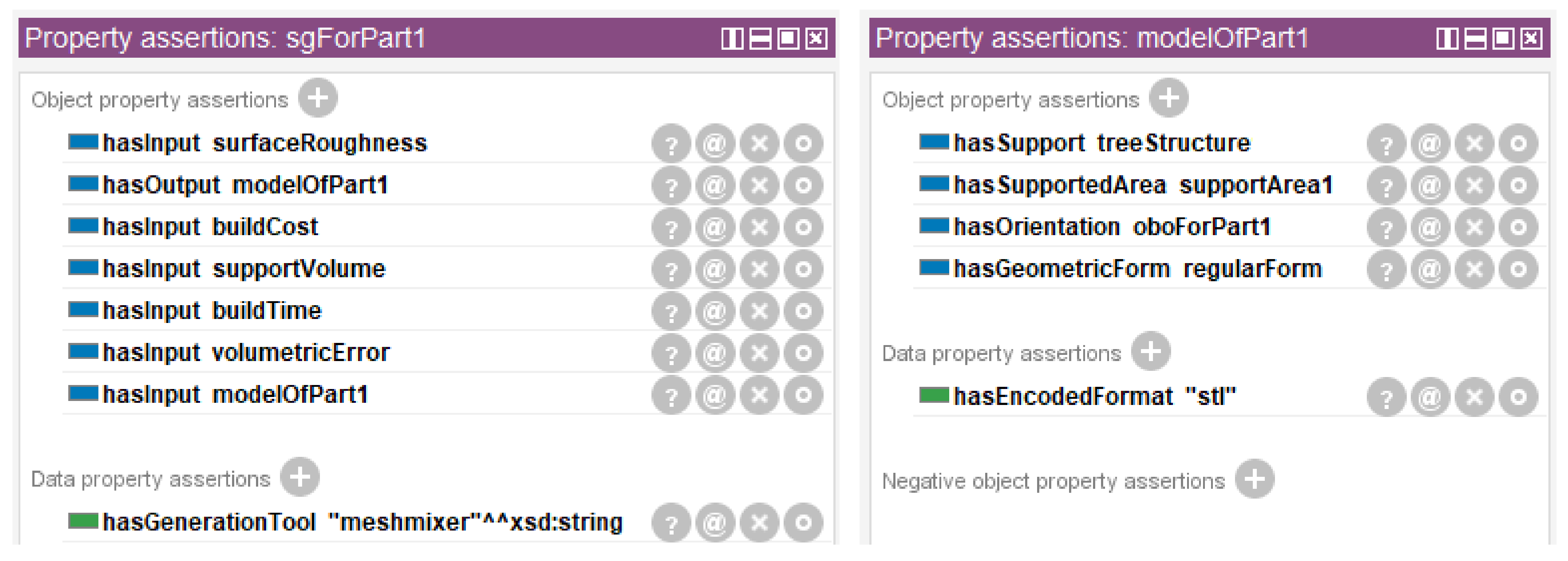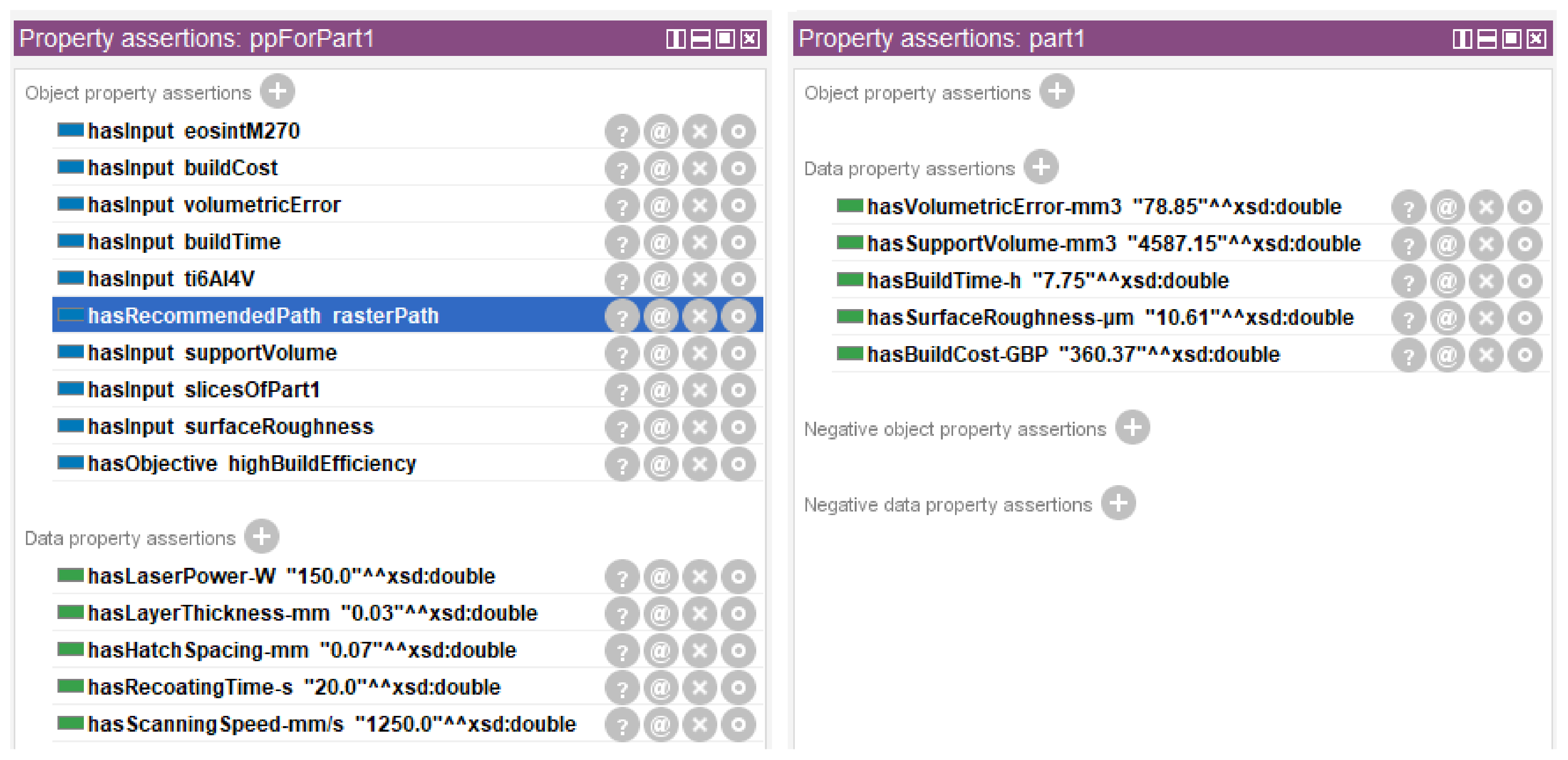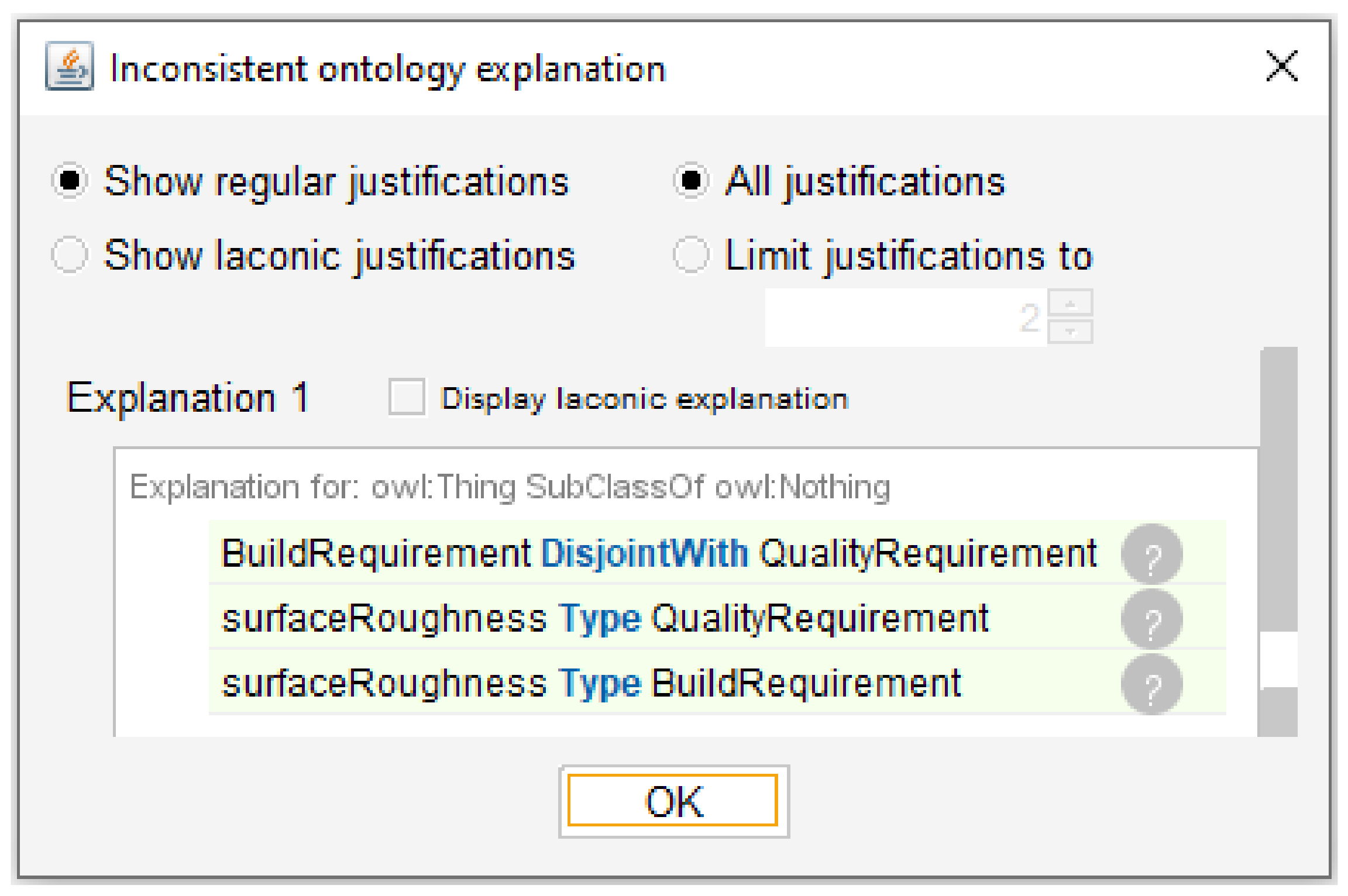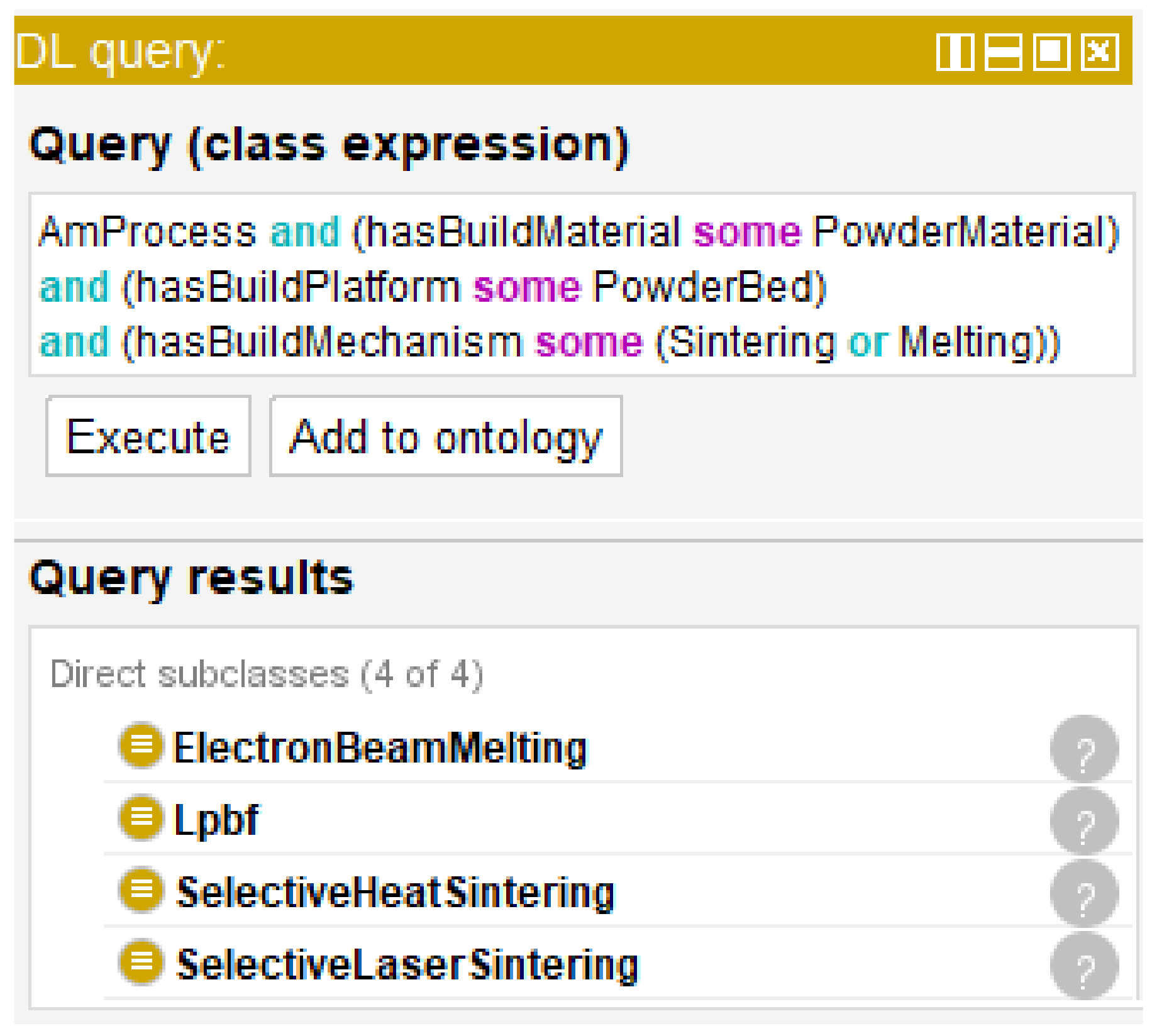1. Introduction
Laser powder bed fusion (LPBF) is an additive manufacturing (AM) process that uses a laser beam to selectively melt metallic powders together to additively manufacture metal parts [
1]. The schematic of this process is depicted in
Figure 1. An LPBF machine mainly includes a powder bed, a powder delivery apparatus, a build platform, a recoater blade, a rotating mirror, and a laser beam source. The process of using an LPBF machine to fabricate a three-dimensional (3D) part generally consists of the following steps:
A layer of powder material with specified thickness is spread over the build platform from the powder delivery apparatus by the recoater blade;
A moving laser beam with certain power selectively scans the layer of powder material with certain speed to create a layer of the 3D part;
The build platform steps down by one layer thickness and a new layer of powder material is distributed evenly across the build platform;
The second and third steps are repeated until the 3D part is fully built.
LPBF has advantages in providing high flexibility for geometric design and achieving geometric complexity without additional cost, which are the common advantages of AM technologies over traditional manufacturing technologies. More importantly, LPBF enables rapid fabrication of different metallic parts in a mixed batch with near full density and high precision, strength, and stiffness directly from metallic powders at no extra cost [
2]. This feature makes it an attractive technology for producing functional components in a number of key industrial sectors, such as the aerospace, automotive, and biomedical sectors [
3].
Figure 1.
Schematic diagram of the LPBF process.
Figure 1.
Schematic diagram of the LPBF process.
In general, the process of using LPBF to realise a part meeting certain quality requirements includes a set of activities, where process planning is an important one. In conventional manufacturing, process planning is an activity of determining appropriate sequence of operations and process variables for converting a workpiece from an engineering drawing to its final form. In LPBF, the engineering drawing is replaced by a 3D model. The aim of process planning remains the same, namely to determine appropriate sequence of LPBF operations or process variables to enable efficient and accurate build of an LPBF part from its 3D model. In process planning for LPBF, the process variables to be designed include build orientation, support structure, slices, laser scanning path, and process parameters. These variables are widely recognised as fundamental factors that have important influence on the quality of the built part [
4,
5,
6,
7,
8]. However, process planning for LPBF is still considered as a challenging activity [
9,
10] because of the following reasons. Firstly, the physical and chemical processes of LPBF are complex. The lack of a complete understanding of these underlying processes brings great difficulty to the development of optimal process planning methods to build high-quality components [
2]. Secondly, most of the existing process planning methods for LPBF focus on specific variables, materials, or structures rather than general strategies. They are difficult to be transferred directly to a build with new variables, materials, or structures. Thirdly, most of the current process planning tools for LPBF are configured by users manually without a standard procedure. There is not yet a tool with autonomous decision-making capability [
4,
5,
6,
7,
8]. These limitations necessitate a process planning knowledge base that enables the capture, representation, inference, and reuse of existing knowledge about the LPBF process.
In this paper, a description logic (DL) based ontology for knowledge representation in process planning for LPBF is constructed. DLs, a family of formal knowledge representation languages, are well-known for providing rigorous logic-based semantics to support knowledge reasoning [
11]. Ontology, a shared, explicit, and formalised specification of concepts, relations, instances, and axioms in an application domain, provides effective means to capture, represent, and reuse domain knowledge [
12]. A DL-based ontology is an ontology using a DL as representation language. The most prominent feature of DL-based ontologies is that they can achieve semantic representation and exchange and knowledge discovery and reuse. Although application of DL-based ontologies is rooted in the field of semantic web, it has been extended to many other fields during the past three decades. In the field of advanced manufacturing, DL-based ontologies have been used to improve the interoperability of industrial information systems [
13], achieve knowledge reuse and discovery in product lifecycle management [
14], exchange computer-aided design model data [
15], and implement intelligent design of tolerance specifications [
16]. Through a DL-based ontology, the knowledge in process planning for LPBF can be formalised in DL and semantic web rule language (SWRL) [
17] and represented and stored in web ontology language (OWL) [
18]. As three benefits of the constructed DL-based ontology, consistency checking, knowledge reasoning, and semantic query can be performed via DL, DL and SWRL, and DL, sparql protocol and rdf query language (SPARQL) [
19], and semantic query-enhanced web rule language (SQWRL) [
20], respectively.
The remainder of the paper is organised as follows: an overview of related work is provided in
Section 2. The details of the constructed DL-based ontology are explained in
Section 3.
Section 4 documents an application of the ontology and illustrations of the benefits of the ontology.
Section 5 ends the paper with a conclusion.
2. Related Work
An ideal model for AM knowledge representation is preferably a standardised model for practical applications [
21]. During the past few decades, many standardised models for data representation in AM have been developed [
22], but there has not yet been a standardised model for knowledge representation in AM. To fill this gap, many models have been presented within academia, which can be divided into the following categories based on the knowledge representation methods used in them:
Graph model [
23]: this model was presented to formulate the design guidelines for AM. In the model, a set of design guidelines for AM are first defined in a graph form based on relevant literature. Then, the 3D model of a component is decomposed into a group of constitutive features. These features and the relationships between them are identified and represented using graphs. After that, the defined design guidelines are leveraged to revise the offending features to alleviate the manufacturability issue. Finally, the best design for component build is obtained via repeating the first three steps iteratively. The approach can be used by those designers who find it difficult to integrate all the constraints into a unified AM design process. However, it improves the AM design only on the basis of manufacturability. Mechanical strength is not considered in the improvement.
Finite state automata model [
24]: this model was constructed to represent AM design knowledge to support personalised AM. In the model, a formal design process structure combining design for personalisation and design for AM is first established. Then, the artifact-user interactions are formally represented using a finite state automata based on the established structure. Through applying the affordance, effectivity, and preference properties, the artifact properties related to behaviours and preferences of users are systemically linked to design requirements of AM artifacts. The finite state automata model provides a set of formal representations that capture design requirements to improve personalisation level of AM while maintaining the freedom of AM design. However, it can only be applied to the stages of conceptual design and preliminary design and has not yet been included for consideration of process planning.
Network model [
25]: this model was developed to simulate AM processes. In the model, the system of direct material deposition process is taken as an illustrative case study. Networks are first used to visualise the general view of the system functions and the causal relationships between system variables. Then, a set of causal graphs between governing dimensionless products are defined to simplify the causal graphs between system variables. Through the simplification, the causal relationships between system variables are directly extracted before carrying out experiments. The network model provides a feasible way to simulate the direct material deposition process. However, it still needs to be further extended when it is utilised to simulate other AM processes.
Function modelling language model [
26]: this model was established to structurally represent the process-related data and knowledge in LPBF using a function modelling language and align them with specific sub-processes of powder bed fusion. It classifies an LPBF product realisation process into six activities, which are product modelling, product model tessellation, process planning, monitoring and control, post process, and quality inspection. On the basis of such classification, the activities process planning and monitoring and control and the data and knowledge associated with them are modelled. The function modelling language model provides a way to understand the organisation of LPBF product realisation process activities and sub-activities and the data flows among them. It also provides a common terminology and new process knowledge for LPBF data management. However, the model is just a conceptual model of the activities. The modelling of specific data and knowledge in each activity is not included.
Worksheet model [
27]: this model was presented to simplify the guidelines of design for AM for novice and intermittent users. In the model, the existing guidelines of AM design are firstly summarised from a certain number of representative research articles. Based on the summarisation, a one-page visual worksheet of the guidelines of design for AM is developed. The effectiveness of the worksheet is demonstrated via several test experiments. The worksheet model can help designers evaluate the potential quality of a component manufactured by AM processes and indirectly recommend feasible methods to redesign it. Its direct benefit is to filter out bad designs before manufacturing, which reduces the time spent on manufacturing and redesign. However, the model is based on the samples provided by a single source, which could limit its potential performance.
Formal rule model [
28]: this model was constructed to represent the design rules with modularity for AM. In the model, the fundamental relations among geometry, process, and material are first decomposed into reusable modules. Then, the modules are described using if-then rules. On the basis of the rules, parts are specialised to represent the process-related parameters for different AM processes. The formal rule model provides consistent and repeatable interpretations of an AM design guideline in different design and process conditions. It can also be used to explain the design principles that are independent of process to those users who are not familiar with AM technologies. Since the core of the model is to reconfigure the existing design rules, rather than to develop new rules, the basic AM principles can be preserved, and meanwhile the customisation and explicit representation of AM design rules can be implemented.
Bayesian network model [
29]: this model was established to fill the knowledge gap between designers and AM technologies. It is hierarchically organised and consists of an overview layer and a detailed information layer. Different types of nodes and their causal relationships in each layer are characterised by Bayesian networks. A knowledge management system for supporting AM was then developed. This system can help designers understand the capabilities of AM processes and form appropriate design solutions at the design stage, which reduces the uncertainty of AM processes to some extent.
Category theory model [
30]: this model was developed to formalise general knowledge in design and process control for powder bed fusion. In the model, a collection of guidelines and rules for these two activities are encapsulated and represented using categorical structures. The category theory model provides a framework to captured, accessed, and interrogated the structured knowledge. However, it has not yet included the representation of specific data in the two activities.
A summarisation of the models above at the aspects of published year, representation method, represented specific AM knowledge, and targeted AM process is provided in
Table 1. In addition to these models, the use of ontologies in AM knowledge representation has been gained importance and popularity within academia during the past two decades. Many ontologies [
31,
32,
33,
34,
35,
36,
37,
38,
39,
40,
41,
42,
43,
44,
45,
46,
47,
48,
49,
50,
51,
52] have been presented in this period. A summarisation of these ontologies at the aspects of published year, representation languages, represented specific AM knowledge, and targeted AM process is provided in
Table 2.
As can be seen from
Table 1 and
Table 2, each model/ontology has its specific usage in AM knowledge representation. Some models/ontologies are targeted at general AM processes, while each of other models/ontologies is constructed for one specific AM process, including direct material deposition, LPBF, powder bed fusion, lithography-based ceramic manufacturing, or wire arc additive manufacturing. It can also be seen from the two tables that the models and ontologies related to knowledge representation in process planning for LPBF include the function modelling language model [
26], category theory model [
30], and ontologies in [
31,
32,
33,
35,
37,
39,
40,
42,
43,
47,
48,
49]. However, research gap is evident due to the following reasons: both the function modelling language model [
26] and category theory model [
30] are conceptual models and do not involve the modelling of specific data and knowledge in process planning for LPBF; the ontologies in [
31,
32,
33,
35,
37,
39,
40,
42,
43] are targeted at general AM processes and are difficult to be applied to process planning for LPBF directly (need further modifications and extensions); although the ontologies in [
47,
48,
49] were all developed for the LPBF process, their main purpose is not to represent the knowledge at the process planning stage. To fill the research gap, a DL-based ontology dedicated to knowledge representation in process planning for LPBF is presented in this paper.
3. DL-Based Ontology
A DL-based ontology generally consists of a DL terminology box (TBox), a DL assertion box (ABox), and a set of SWRL rules. The DL TBox is a collection of concepts, relations, and definitions of concepts (terminological axioms). A set of concept assertions, relation assertions, and instance assertions (assertional axioms) constitute the DL ABox. The SWRL rules are used to describe the knowledge that cannot be described by DL. In this section, a DL-based ontology for representation of the LPBF process planning knowledge is developed using Protégé [
53] according to standard terminologies for LPBF (ISO/ASTM 52900, 2021), LPBF process planning guidelines (ISO/ASTM 52911-1, 2019; ISO/ASTM 52911-2, 2019), database of LPBF materials [
54], database of LPBF machines [
54], and existing related research results [
4,
5,
6,
7,
8]. The schematic diagram of this ontology is shown in
Figure 2. Benefiting from the advantages of the developed ontology, the semantics of LPBF process planning data are enriched greatly, and consistency checking, knowledge reasoning, and semantic query, which are not available in current process planning tools for LPBF, can be performed via DL, DL, and SWRL, and DL, SPARQL, and SQWRL, respectively.
In the following subsections, the details of the ontology will be described in a top-down manner. For the sake of clarity, the following labelling convention will be adopted: all entity names are in italics (e.g., LpbfMachine, isBasedOn, eosintM270); the first letters of all DL concept (OWL class) names are in capitalised case (e.g., Lpbf, ProcessPlanning); all DL relation (OWL property) names have a prefix of ‘has’ or ‘is’ (e.g., hasEnergySource, isApplicableFor); the first letters of all DL instance (OWL individual) names are in lower case (e.g., ti6Al4V, alSi10Mg).
3.1. Top-Level Entities
LPBF is an AM process whose energy source is a laser beam, build material is a powder material, build platform is a powder bed, and build mechanism is melting. Process planning for LPBF is a product realisation activity that aims to design appropriate process variables to build a part that can satisfy certain build and quality requirements. The main inputs of this activity include a 3D model, an LPBF material, an LPBF machine, and build and quality requirements. The outputs of the activity are a set of process variables, which include build orientation, support structure, slices, laser scanning path, and process parameters. Process planning consists of four successive tasks that of part orientation, that of support generation, that of model slicing, and that of path planning [
55].
Based on the description above, twenty-eight top-level concepts were created and depicted in
Figure 3. Among them,
Lpbf,
LpbfPart,
LpbfMaterial,
LpbfMachine,
ProcessPlanning,
PartOrientation,
SupportGeneration,
ModelSlicing, and
PathPlanning are composite concepts (concepts that need to be defined by other concepts), while the remaining concepts are atomic concepts (concepts that cannot be defined by other concepts). The DL definitions of the nine composite concepts are given by the following terminological axioms:
where ≡ is the concept definition symbol in DLs which is used to define a concept, ∃ is the existential restriction symbol in DLs which is used to denote that there are one or more instances of a concept that have a specific relation, ⊓ is the concept conjunction symbol in DLs which is used to obtain the intersection of instances of two concepts, and
hasEnergySource,
hasBuildMaterial,
hasBuildPlatform,
hasBuildMechanism,
hasAimOfDesigning,
isManufacturedUsing,
isApplicableFor, and
isBasedOn are object relations whose domain, range, and meaning are listed in
Table 3.
The build and quality requirements are specified by process planners based on certain indicators. Indicators for describing the build requirements of an LPBF part mainly include support volume, build time, and build cost, while indicators for specifying the quality requirements of an LPBF part mainly contain dimensional error, geometric error, volumetric error, surface roughness, density, hardness, yield strength, tensile strength, elongation, residual stress, and fatigue strength. In the process of planning for LPBF, the values of these indicators for an LPBF part to be built are usually predicted via certain prediction models. To describe indicator values, fourteen top-level data relations named hasSupportVolume-mm3, hasBuildTime-h, hasBuildCost-GBP, hasDimensionalError-mm, hasGeometricError-mm, hasVolumetricError-mm3, hasSurfaceRoughness-μm, hasDensity-g/cm3, hasHardness-HV, hasYieldStrength-MPa, hasTensileStrength-MPa, hasElongation-Pct, hasResidualStress-MPa, and hasFatigueStrength-MPa were created. The domain and range of each data relation are respectively LpbfPart and xsd:double. This means that an LPBF part has predicted indicator value of xsd:double.
The widely known LPBF materials include Ti6Al4V, AlSi10Mg, stainless steel, and tool steel. Recently, several other types of LPBF materials, such as tungsten, zinc alloy, magnesium alloy, and metal matrix composite, have been developed [
56]. Therefore, eight assertional axioms were created as follows:
LpbfMaterial(
ti6Al4V);
LpbfMaterial(
alSi10Mg);
LpbfMaterial(
stainlessSteel);
LpbfMaterial(
toolSteel);
LpbfMaterial(
tungsten);
LpbfMaterial(
zincAlloy);
LpbfMaterial(
magnesiumAlloy);
LpbfMaterial(
metalMatrixComposite). According to the Senvol Database [
54], there have been two hundred and thirty-six LPBF machines available in the market to date. The names of these LPBF machines were used to instantiate the concept
LpbfMachine to create two hundred and thirty-six assertional axioms. For example, in the database, EOSINT M270 is an LPBF machine. An assertional axiom
LpbfMachine(
eosintM270) was created to make this assertion.
3.2. Entities for Part Orientation
Part orientation is a process planning task that aims to design a build orientation that best meets the build and quality requirements to build a part [
4]. The main inputs of this task include a 3D model of a part to be built and specific build and quality requirements on the part. Its output is a 3D model in a build orientation. The 3D model is the results of the design activity and generally encoded in a specific format [
22], such as the STL (standard tessellation language) format, 3MF (3D manufacturing file) format, and AMF (additive manufacturing file) format.
Existing methods for part orientation can be classified into search-based methods and rule-based methods [
4]. Search-based methods take the part orientation problem as a multi-objective optimisation problem. They usually adopts specific search algorithms, such as the random search algorithm [
57], genetic algorithm [
58], particle swarm algorithm [
59], and iterative tabu search algorithm [
60], to search an orientation that can optimise multiple objectives at the same time from infinite possible orientations. In search-based methods, a build orientation is generally expressed via an angle pair
, where the build orientation lines up along the +
z axis after rotating the 3D model
(
) degrees around the
x axis and
(
) degrees around the
y axis. Search-based methods usually have relatively high accuracy and relatively low efficiency. They are generally applied to free-form surface models.
Rule-based methods take the part orientation problem as a multi-objective decision-making problem. It first generates a certain number of alternative orientations from infinite possible orientations via performing shape feature recognition [
61,
62] or triangular facet clustering [
63,
64,
65] on the 3D model and carrying out rule-based reasoning according to the recognition or clustering results. Then, a multi-objective decision-making method is used to select an orientation from the alternative orientations that can satisfy multiple objectives at the same time. In rule-based methods, a build orientation is generally represented by a unit vector
. Rule-based methods are relatively efficient, since they do not spend time on many meaningless calculations. However, they are difficult to achieve desired accuracy on free-form surface models. They are more suitable for regular surface models.
Based on the analysis above, it is recommended to use a rule-based method for part orientation when the input 3D model is a regular surface model and to use a search-based method on a free-form surface model.
To represent the knowledge in part orientation, seven concepts named
Objective,
Method,
SearchBasedMethod,
RuleBasedMethod,
AnglePair,
UnitVector, and
Form, sixteen relations listed in
Table 4, four instances named
methodInRef57,
methodInRef58,
methodInRef59, and
methodInRef60 (instances of
SearchBasedMethod), and five instances named
methodInRef61,
methodInRef62,
methodInRef63,
methodInRef64, and
methodInRef65 (instances of
RuleBasedMethod) were created. Based on these entities, an ontological view of part orientation for LPBF is delineated in
Figure 4, and two SWRL rules for recommending a part orientation method for an input 3D model were developed as follows:
where the statements on the left and right of → are respectively the antecedent and consequent of an SWRL rule,
denotes that if the antecedent holds then the consequent holds,
(
is a DL concept) or
(
is a DL relation) is an atom in an SWRL rule which is used to describe a condition, ∧ is the atom conjunction symbol in an SWRL rule which denotes ‘and’, each variable is marked using a question mark as its prefix, and
freeForm and
regularForm are instances of
Form.
3.3. Entities for Support Generation
Support generation is a process planning task that aims to generate the minimum amount of support structure that best meets the build and quality requirements to build a part [
5]. The main inputs of this task include a 3D model in a build orientation for a part to be built and specific build and quality requirements on the part. Its output is a 3D model with support structure in a build orientation.
To generate the support structure for a 3D model in a given build orientation, the first step is to detect the overhang area on the model that needs to be supported. In existing support generation methods, this detection is generally carried out using the angles between the normal vectors of triangular facets and the build orientation. When the angle corresponding to a triangular facet is greater than a certain value, the area corresponding to the triangular facet is considered to be the overhang area that needs to be supported [
5].
After detecting the supported overhang area, a specific shape of support structure will be generated for it. So far, a number of different shapes of support structures for AM part build have been developed [
5]. The support structures suitable for LPBF part build mainly include lattice support structure [
66], cellular support structure [
67], unit cell support structure [
68], pin support structure [
69], Y support structure [
69], IY support structure [
69], and tree support structure [
70]. In practice, which shape of support structure to use is usually determined by the used process planning tool, since each process planning tool provides its specific shapes of support structures.
Support generation is usually coupled with optimising the selected shape of support structure to minimise its total volume and improve part quality. To date, many optimisation methods have ben presented within academia. For example, a lattice support structure optimisation method based on Taguchi experiment was presented in [
71]; a lattice support structure optimisation framework based on genetic algorithm was established in [
72]; in [
59], a topology optimisation method was used to optimise lattice support structure to prevent residual stress induced build failure; in [
73], the topology of lattice support structure is optimised to maximise its thermal conductivity and to mitigate the effect of thermal stress on the dimensional and geometric accuracy of an LPBF part; a method for optimising the topology of lattice support structure is presented in [
74]; a hybrid optimisation framework for topology, build orientation, and support structure is established in [
75]. These methods provide practical tools for optimisation of the support structure of an LPBF part. They can be selected according to specific optimisation objects and objectives.
To represent the knowledge in support generation, a concept named
SupportedArea, five relations listed in
Table 5, and seven instances named
latticeStructure,
cellularStructure,
unitCellStructure,
pinStructure,
yStructure,
iyStructure, and
treeStructure (instances of
SupportStructure) were created. Using these entities, an ontological view of support generation for LPBF is delineated in
Figure 5.
3.4. Entities for Model Slicing
Model slicing is a process planning task that aims to truncate the build model (i.e., a 3D model with support structure) into a set of thin slices that best meet the build and quality requirements to build a part [
6]. The main inputs of this task include an LPBF machine, a 3D model with support structure in a build orientation for a part to be built, and specific build and quality requirements on the part. Its outputs are a set of thin slices. A slice corresponds to a layer of the part to be built. The main attributes of a slice are its contour and thickness. This thickness is usually called layer thickness, which is one of the critical LPBF process parameters. The output slice information is generally encoded in a proprietary format [
22], such as the CLI (common layer interface), SLC (stereo lithography contour), and HPGL (Hewlett-Packard graphics language) format.
The simplest model slicing strategy is uniform slicing in single direction, which truncates the build model into a set of slices with equal thickness along the direction perpendicular to the build orientation. It is the first model slicing strategy in AM and is the most widely used strategy in industry [
6]. The biggest advantage of the uniform slicing in single direction is that it is simple, efficient, and robust. However, this strategy would lead to a loss of control over the part accuracy, since it neglects the actual geometry of the build model [
55].
In the past few years, a number of improvement strategies were developed [
76,
77,
78], where representative ones are uniform slicing in multiple directions, variable slicing in single direction, and variable slicing in multiple directions. Each strategy has its specific characteristics. Generally, a slicing strategy is selected based on actual objectives [
6]:
if the objectives of model slicing are normal accuracy and high efficiency, then uniform slicing in single direction (ussd) is recommended;
if the objectives of model slicing are normal accuracy, reduced support, and alleviated anisotropy, then uniform slicing in multiple directions (usmd) is recommended;
if the objective of model slicing is high accuracy, then variable slicing in single direction (vssd) is recommended;
if the objectives of model slicing are high accuracy, free of support, and alleviated anisotropy, then variable slicing in multiple directions (vsmd) is recommended.
To represent the knowledge in model slicing, two concepts named
SliceContour and
SlicingStrategy, three relations listed in
Table 6, and four instances named
ussd,
usmd,
vssd, and
vsmd (instances of
SlicingStrategy) were created. Based on these entities, an ontological view of model slicing for LPBF is delineated in
Figure 6, and four SWRL rules for recommending a model slicing strategy were developed as follows:
where
normalAccuracy,
highEfficiency,
reducedSupport,
alleviatedAnisotropy,
highAccuracy, and
freeOfSupport are instances of
Objective.
3.5. Entities for Path Planning
Path planning is a process planning task that aims to design a laser scanning path and a set of process parameters that best meets the build and quality requirements to build a part [
6,
7]. The main inputs of this task include an LPBF material, an LPBF machine, a set of slices for a part to be built, and specific build and quality requirements on the part. Its outputs are a laser scanning path and a set of process parameters.
An important step in path planning is to select or develop a proper laser scanning path. This step is affected by the adopted model slicing strategy. If a planar slicing strategy is adopted, alternative path patterns mainly include raster, zigzag, multi-direction, grid, spiral, contour, and hybrid paths. Each path has its specific strengths and shortcomings. In general, the path patterns are selected according to specific objectives [
6]:
If the objective of path planning is high build efficiency, then raster path is recommended;
If the objectives of path planning are high build efficiency and high mechanical performance, then zigzag path or grid path is recommended;
If the objectives of path planning are high geometric accuracy and high mechanical performance, then multi-direction path or contour path is recommended;
If the objectives of path planning are high geometric accuracy, less path passes, less path elements, and high mechanical performance, then spiral path is recommended;
If the objectives of path planning are high build efficiency and high geometric accuracy, then hybrid path is recommended.
Another important step in path planning is to design a set of optimal process parameters. According to the study in [
79], controllable process parameters include layer thickness, laser power, scanning speed, hatch spacing, recoating time, recoating speed, dosing per layer, bulk temperature, oxygen level, chamber pressure, gas flow speed, and ambient temperature. Among them, layer thickness, laser power, scanning speed, and hatch spacing are four critical process parameters. The volumetric energy density calculated from them is an important indicator to measure the effect of process parameters on part quality [
80]. For design of process parameters, most of existing methods first generate a set of combinations of process parameters, then predict certain part quality indicators under each combination, and finally determine the optimal process parameters on the basis of the prediction results [
8].
To represent the knowledge in path planning, an object relation named
hasRecommendedPath, thirteen data relations named
hasLayerThickness-mm,
hasLaserPower-W,
hasScanningSpeed-mm/s,
hasHatchSpacing-mm,
hasLaserSpotDiameter-mm,
hasRecoatingTime-s,
hasRecoatingSpeed-mm/s,
hasDosingPerLayer-Pct,
hasBulkTemperature-DegC,
hasOxygenLevel-Pct,
hasChamberPressure-kPa,
hasGasFlowSpeed-m3/s, and
hasAmbientTemperature-DegC, and seven instances named
rasterPath,
zigzagPath,
multiDirectionPath,
gridPath,
spiralPath,
contourPath, and
hybridPath (instances of
LaserScanningPath) were created. The domain and range of the object relation are respectively
PathPlanning and
ScanningPath. This means that a path planning task has designed laser scanning path of (a specific scanning path). The domain and range of each data relation are respectively
PathPlanning and xsd:double. This means that a path planning task has designed process parameter value of xsd:double. Based on the crated entities, an ontological view of path planning for LPBF is delineated in
Figure 7, and seven SWRL rules for recommending a laser scanning path were developed as follows:
where
highBuildEfficiency,
highMechanicalPerformance,
highGeometricAccuracy,
lessPathPasses, and
lessPathElements are instances of
Objective.
5. Conclusions
In this paper, a DL-based ontology with SWRL rules for knowledge representation in process planning for LPBF is developed. Firstly, a set of top-level DL concepts, DL relations, DL instances, and DL axioms are created to represent the knowledge in general process planning activity. Then, specific DL concepts, DL relations, DL instances, and SWRL rules are respectively developed to describe the knowledge in part orientation, support generation, model slicing, and path planning. After that, the application of the developed ontology is demonstrated via process planning on an LPBF part. Finally, the benefits of the ontology are outlined and illustrated using examples. The illustration results show that the ontology has rigorous computer-interpretable semantics, which would lay solid basis for development of an LPBF process planning tool with autonomous decision-making capability.
Each of existing LPBF process planning tool has its specific knowledge representation method. Although ontology-based method has advantages in automatic consistency checking, knowledge reasoning, and semantic query and is gaining importance and popularity in AM knowledge representation, it should not be considered as a complete replacement of the methods used in existing tools, but more as an alternative method to improve them in some aspects. At present, existing ontologies for knowledge representation in LPBF are not yet mature. More powerful ontologies and related tools that can realise autonomous decision-making need to be further investigated.
Future work will aim especially at improving the developed DL-based ontology to overcome a main limitation: knowledge representation in process planning for multi-part production is not considered. An important feature of LPBF is that it enables rapid fabrication of multiple different parts in a mixed batch [
60]. The developed ontology focuses on knowledge representation in process planning for production of one single part, it cannot be applied to the situation where multiple parts in the same build need to be planned simultaneously. From the perspective of application, it is of necessity and importance to improve the ontology to handle this situation. Further, the conventional LPBF process planning pipeline is somewhat complex and a simpler pipeline has been presented in [
82]. It would be interesting to develop a DL-based ontology for this simpler pipeline.
